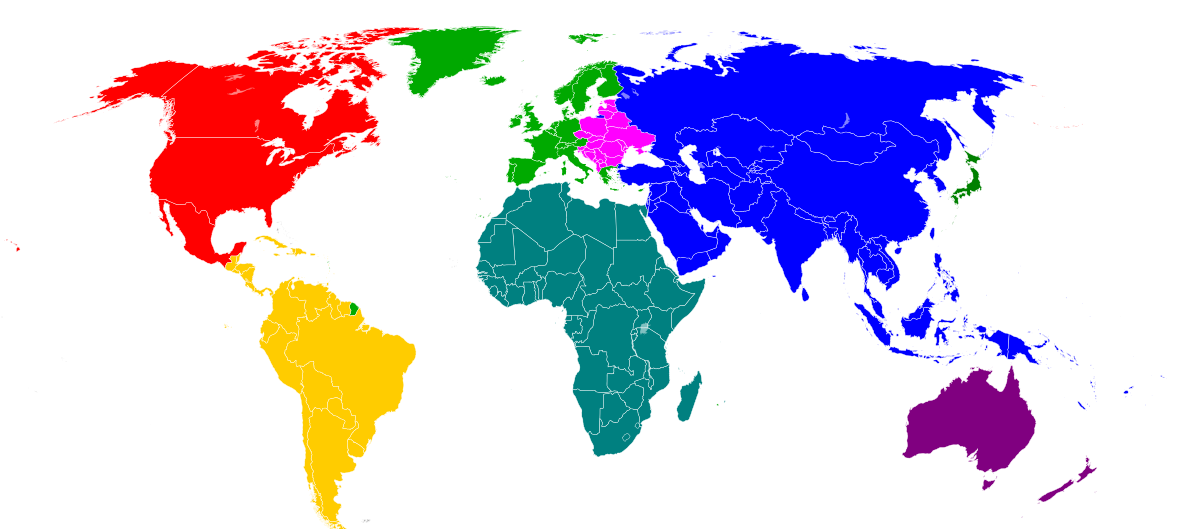Master System consoles in Europe
From Sega Retro
Like the equivalent Mega Drive page, this page is a complete mess. We have pictures of 1986 German console boxes next to countries which didn't receive the Master System until well into the 1990s, along with many other discrepancies. Please only add pictures of consoles from the actual country listed (preferably with something specific for that country, ie distributor sticker, localised manual etc).--Pirate Dragon (talk) 17:12, 20 August 2018 (CDT)
- Yeah I fear there's been an assumption that all boxes are the same. Which they might be... but I'd rather have a dozen duplicate scans to prove it rather than making that assumption. And I fully expect the backs of boxes to have different distribution details on them at the very least.
- The other issue with both this page and the Mega Drive one, is that the list is huge and unorganised. What we probably need to do as a collective is
- a) come up with a preferred order for countries, which we can then apply everywhere to every wiki.
- b) decide if we want to split up Europe into north, south, east and west. I looked into this once, but it turns out it's not even consistent within the UN, nevermind all the other big multi-national organisations that try and group things.
- And where there wasn't really a license to distribute Sega consoles officially, we should be treating that as something else. Maybe. -Black Squirrel (talk) 04:20, 21 August 2018 (CDT)
But models with distributor stickers did not exist in those regions. For example, Romania or Croatia do not even know that Sega had a distributor in this country. Famiclons were the most popular and they could be bought everywhere and original consoles could only be bought in the capital of the country or the largest city and at huge prices. Most of the models are just the same from Germany. Some instructions were made but made by third party companies and were added to only some models that were sold in their stores. On some consoles new bar codes were stuck. You can look for consoles with a distributor sticker but there is little chance of finding it.-Lukdriver14 (talk) 04:45, 21 August 2018 (CDT)
- I made a map
- I stole this map from Wikimedia Commons and made a rough guide to where, from a Sega perspective, the regions of the world seem to lie. I think it's important to group the UK, France, Spain and Germany together - how the rest of Europe looks doesn't bother me so much. I put Turkey in Europe - maybe it shouldn't be. idk.
- The idea, basically, is that this page would get split into three or four. It might be easier to put Italy in "Western Europe" and class the rest as "central and southern" but I'll leave that to someone else. This is a nice SVG so changing colours for each country is easy.
- I don't think it's worth dividing the world up into any more regions (e.g. "South Asia") - if we were the United Nations, then it might be a good idea, but given that Sega didn't have official distribution channels in most of the world, there probably wouldn't be much to talk about. -Black Squirrel (talk) 12:24, 21 August 2018 (CDT)
Good idea. I searched the action sites and various websites of game museums in Eastern Europe, but as I said, there are no distributor stickers. Most of them are models from European editions (also German ones). [1] [2] [3] [4] This one have some barcode [5] [6] [7] Standards such as distribution labels (in terms of consoles) appeared in these countries a little later. I do not count Dendy's company which operated in many countries and tried very much to become similar to Western European companies. But there is always a chance that someone will find some models with stickers or instructions.
Lukdriver14 (talk) 13:58 , 21 August 2018 (CDT)
- I don't think auction sites are enough to prove that a console was sold in a particular country, especially if there no labels or localised documentation to go along with it. If it looks like German stock, it might actually be German stock - consoles that have just ended up in Poland or the Czech Republic or whatever because they're on the border. If there was no official distribution channels, importing from Germany might have been the only option you had, just like all those Mega Drive consoles imported into Europe from Japan during 1989/1990.
- If it can be proven that Sega intended to sell a console in a country, then it should be documented on these pages, otherwise we're just duplicating information by documenting a German release multiple times. -Black Squirrel (talk) 15:03, 21 August 2018 (CDT)
